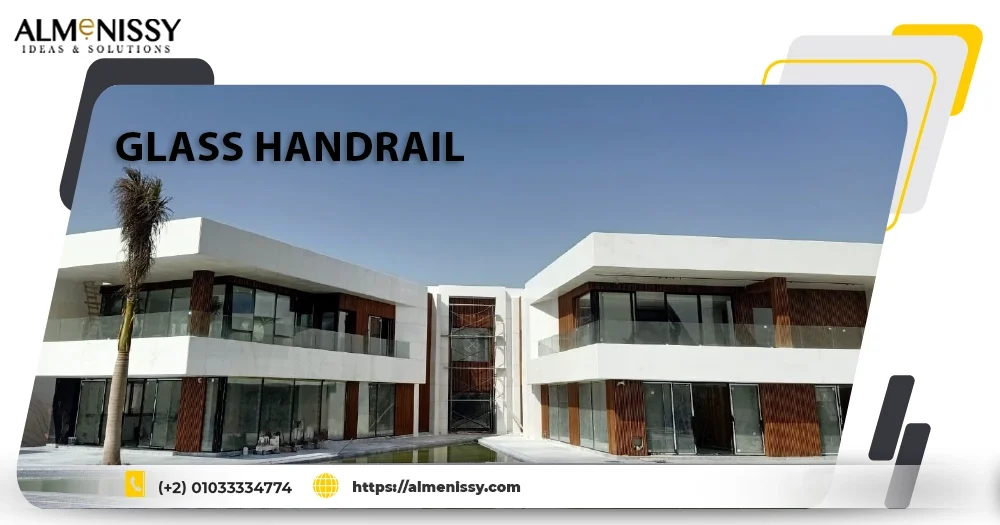Glass handrail are a modern and elegant design feature often used in both residential and commercial buildings. They offer a sleek, transparent barrier that enhances safety without obstructing views. Made from tempered or laminated glass, these handrails are not only durable and strong but also bring a sense of openness and light to any space.
Their versatility allows for use in various settings, from staircases and balconies to terraces and pool areas. Additionally, glass handrail can be customized with different tints, textures, and finishes to complement the aesthetic of any architectural style.
Table of Contents
What is a glass handrail?
A glass handrail is a safety railing system primarily constructed using glass panels. These handrails are designed to provide a protective barrier while maintaining transparency, thus preserving sightlines and enhancing the aesthetic appeal of the space.
Typically made from tempered or laminated glass for added strength and safety, glass handrail are supported by metal or wooden frames and can be installed in various settings, including staircases, balconies, terraces, and pool areas. They offer a modern, clean look and are often used in both residential and commercial buildings to create a sense of openness and light.
What type of glass is used in railings?
The types of glass commonly used in railings are tempered glass and laminated glass.
- Tempered Glass: If it breaks, it shatters into small, blunt pieces, reducing the risk of injury. Tempered glass’s longevity and security characteristics make it a popular choice.
- Laminated Glass: This glass consists of two or more layers of glass bonded together with an interlayer, usually made of polyvinyl butyral (PVB). If it breaks, the interlayer holds the shards in place, providing an additional safety measure. Laminated glass is valued for its structural integrity and safety.
Both types are chosen for their ability to withstand impact and provide a secure barrier while maintaining a clear and unobstructed view.
How thick are glass railings?
Glass handrail typically range in thickness from 10mm to 21.5mm (approximately 3/8 inch to 7/8 inch). The exact thickness required depends on several factors, including the height of the railing, the width of the glass panels, the design of the support system, and the specific safety and building codes in the area where the railing is being installed.
- 10mm to 12mm (3/8 inch to 1/2 inch): Often used for residential applications where the height and exposure to wind or other forces are lower.
- 15mm to 19mm (5/8 inch to 3/4 inch): Commonly used for commercial applications or where higher safety standards are required.
- 21.5mm (7/8 inch): Typically used in high-load areas or where maximum safety and durability are needed, such as in high-rise buildings or areas with heavy foot traffic.
The choice of thickness ensures the glass can withstand the expected loads and stresses, providing a safe and reliable barrier.
Glass handrail indoor
Indoor glass handrail are a popular choice for modern interiors, offering a sleek and contemporary look that enhances the visual appeal of any space. These handrails are commonly used in areas such as staircases, mezzanines, balconies, and around lofts. They provide a clear, unobstructed view, allowing light to flow freely and making spaces feel more open and spacious.
Benefits of Indoor Glass Handrails:
- Aesthetic Appeal: glass handrail offer a clean, minimalist design that complements various interior styles, from modern to traditional.
- Enhanced Visibility: The transparency of glass allows for unobstructed views, making spaces feel larger and more connected.
- Light Transmission: Glass handrails let in both artificial and natural light, brightening spaces and lowering the need for extra lighting.
- Safety and Durability: Made from tempered or laminated glass, these handrails are strong and safe, providing a secure barrier without compromising on style.
Customization: glass handrail can be tailored to fit any design preference, with options for different tints, textures, and finishes.
How safe is glass railing?
Glass handrail are generally very safe when properly designed, manufactured, and installed. The safety of glass railings is ensured through the use of specific types of glass and adherence to building codes and standards. Here are some key points that contribute to their safety:
1. Types of glass used:
- Tempered Glass: This glass is heat-treated to increase its strength compared to regular glass. If it breaks, it shatters into small, blunt pieces, reducing the risk of serious injury.
- Laminated Glass: This consists of two or more layers of glass bonded with an interlayer, usually made of polyvinyl butyral (PVB). If the glass breaks, the interlayer holds the shards in place, preventing them from falling out and causing harm.
2. Building codes and standards:
- Compliance: Glass railings must comply with local building codes and safety standards, which dictate the minimum thickness, height, and structural requirements to ensure they can withstand various loads and impacts.
- Professional Installation: Proper installation by experienced professionals ensures that the railings are securely anchored and meet all safety specifications.
3. Design considerations:
- Support Structures: The glass panels are supported by sturdy frames, posts, and handrails made from materials like stainless steel, aluminum, or wood, providing additional stability.
- Edge Treatment: The edges of glass panels are often polished to remove sharp corners, further reducing the risk of injury.
4. Maintenance:
- Regular Inspections: Periodic checks for any signs of damage or wear can help maintain the integrity and safety of the glass railing system.
When these factors are taken into account, glass handrail are a safe and reliable option for both indoor and outdoor applications. They offer a combination of strength, durability, and aesthetic appeal while providing a secure barrier.
Conclusion
In conclusion, according to Almenissy company, glass handrail are a sophisticated and practical choice for modern architectural design. They combine safety with aesthetic appeal, enhancing the visual flow and brightness of spaces. Their durability and customizable features make them suitable for various applications, from residential staircases to commercial balconies. By opting for glass handrail, one can achieve a seamless blend of functionality and style, making them a valuable addition to any property.
FAQ
Is glass railing breakable?
Yes, glass railings can break, but they are designed to be highly durable and resistant to impact. The types of glass used in railings—tempered and laminated glass—are specifically chosen for their strength and safety features.
What is glass railing system?
A glass handrail system is a barrier constructed using glass panels as the primary component, designed to provide safety and support in various architectural settings. These systems typically include tempered or laminated glass for strength and durability, often supported by metal or wooden frames, posts, and handrails. glass handrail systems are used in places such as balconies, staircases, decks, and terraces, offering a sleek, modern look that enhances visibility and allows natural light to pass through.


